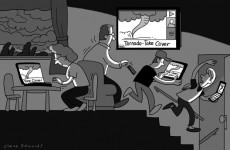“Twister” was released in 1996. The movie about storm chasers and a tornado-filled day in Oklahoma set off a craze of storm chasers and television shows about tornado chasers. Oklahoma weatherman Gary England played a bit role in the movie and performed a key role in the expansion of Oklahoma’s weather coverage.
“I came here in 1972 and at that time the only way you could warn Harry about an incoming tornado was if John’s house down the block was hit by one,” England said. “The means for getting information and getting it out there weren’t very good at the time.”
England set out to find a way to improve available information. He lobbied his station, KWTV Channel 9 in Oklahoma City to go out and buy its own Doppler radar setup. Doppler radar was used to detect the speed and motion of incoming events. The station did and England became the first weatherman to use Doppler to spot severe weather.
Other stations in Oklahoma City, as well as the National Weather Service, started playing catch-up.
“That forced the National Weather Service to do better,” England said. “I was not well-behaved at this time so I’d get on the air at 3 p.m. and say the weather service didn’t put anything out until 3:30. There was a long fight between the private sector and federal about that. It was fierce competition.”
The competition came from other stations trying to catch up to Channel 9 and the weather service, which was unhappy with a local forecaster sending out warnings before it did.
That competition played out in ratings wars as well. Weather is a big deal in Oklahoma, and the station that gets the most viewers following and trusting their news, gets higher ratings. As television stations vied for the weather crowd, England started using time-of-arrival data, using pencils to det
ermine what time a tornado would strike certain cities. Storm chasers and storm spotters were lined up to follow storms and, eventually, to get live video of tornadoes on the ground as the storms approach towns, streets and houses. Helicopters follow the storm and get video. At times, weather coverage in Oklahoma seems so exact that the forecasters can tell what time each street may or may not get hit by a storm.
“We’re just trying to save people’s lives, get some money and get the ratings to go up,” England said. “No matter where you are and what you do, you try to make a better product so people will watch it.”
Competition, and the willingness to spend money, place Oklahoma storm coverage among the best in the nation.
“It became competitive to get the information out there the quickest, and the componies’ had to be willing to spend the money in order to do just that,” England said.
No matter how bad the competition gets, the goal is always to save lives. Oklahoma lost people in the storms in 2011 and England takes each loss personally.
“You want to know what happens and why those people died and you do take it personally. It’s hard to talk about,” England said. At the same time, meteorologists covering Oklahoma have had good moments despite tragedy.
On May 3, 1999, England covered the F-5 tornado that ripped through Oklahoma City. The tornado killed 36 people and caused more than $1 billion in damages. The amazing thing was that only 36 people died. Credit for that went to England and the other two broadcasters covering the storm, Mike Morgan and Rick Mitchell. Studies have shown that their coverage actually saved lives.
Scott Lambert is the managing editor of the Gateway Journalism Review. He worked as a sports journalism and editor for 13 years.

